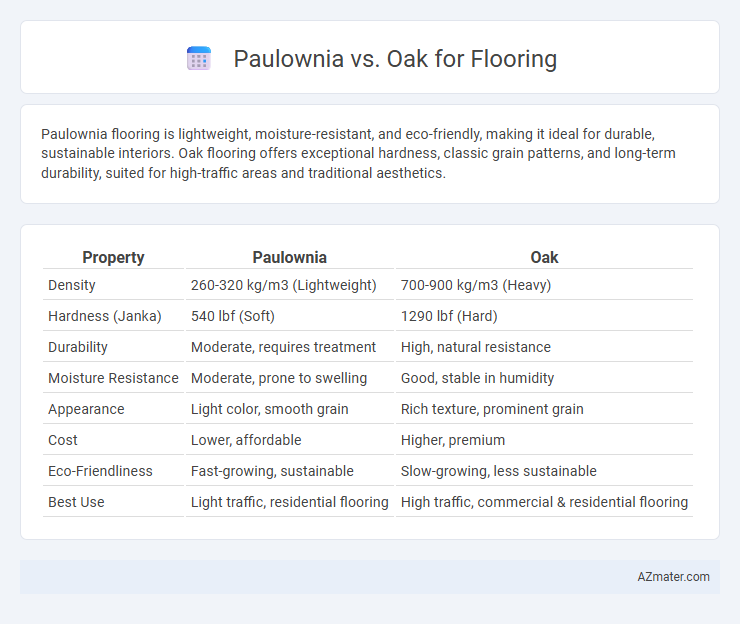Paulownia flooring is lightweight, moisture-resistant, and eco-friendly, making it ideal for durable, sustainable interiors. Oak flooring offers exceptional hardness, classic grain patterns, and long-term durability, suited for high-traffic areas and traditional aesthetics.
Table of Comparison
| Property | Paulownia | Oak |
|---|---|---|
| Density | 260-320 kg/m3 (Lightweight) | 700-900 kg/m3 (Heavy) |
| Hardness (Janka) | 540 lbf (Soft) | 1290 lbf (Hard) |
| Durability | Moderate, requires treatment | High, natural resistance |
| Moisture Resistance | Moderate, prone to swelling | Good, stable in humidity |
| Appearance | Light color, smooth grain | Rich texture, prominent grain |
| Cost | Lower, affordable | Higher, premium |
| Eco-Friendliness | Fast-growing, sustainable | Slow-growing, less sustainable |
| Best Use | Light traffic, residential flooring | High traffic, commercial & residential flooring |
Introduction to Paulownia and Oak Flooring
Paulownia flooring is praised for its lightweight, rapid growth, and natural resistance to moisture and decay, making it an eco-friendly choice for sustainable homes. Oak flooring, renowned for its durability and classic grain patterns, offers long-lasting strength and a timeless aesthetic favored in traditional and modern interiors. Both options provide distinct benefits: Paulownia excels in flexibility and environmental impact, while Oak is preferred for its hardness and refined appearance.
Wood Characteristics: Paulownia vs Oak
Paulownia wood is lightweight and highly resistant to warping and moisture, making it ideal for environments with fluctuating humidity, while oak is significantly denser, offering superior hardness and durability well-suited for high-traffic flooring. Paulownia's softness results in easier cuts and reduced installation effort but lower resistance to dents compared to oak's robust grain structure, which ensures long-lasting performance and scratches resistance. Both woods feature distinct grains, with Paulownia exhibiting a pale, smooth finish and oak displaying a more pronounced, classic grain pattern favored for traditional and rustic flooring aesthetics.
Durability and Hardness Comparison
Paulownia wood is significantly softer than oak, with a Janka hardness rating around 540, making it prone to dents and scratches compared to oak's much higher rating of approximately 1,290. Oak flooring offers superior durability, resisting wear and impact in high-traffic areas better than Paulownia, which is often chosen for its lightweight and quick-growing properties rather than toughness. For long-lasting flooring solutions, oak's hardness ensures a more resilient surface, while Paulownia requires more careful maintenance to avoid damage over time.
Aesthetic Differences: Color and Grain
Paulownia flooring offers a light, blonde color with a subtle, straight grain that creates a clean and modern aesthetic, ideal for bright, minimalist interiors. Oak flooring displays rich, warm tones ranging from light tan to deep brown, featuring prominent, intricate grain patterns that add character and traditional elegance to any space. The choice between Paulownia and Oak hinges on the desired ambiance: Paulownia provides a sleek, airy look, while Oak brings warmth and texture through its bold grain.
Installation and Workability
Paulownia wood offers superior workability compared to oak due to its lighter weight and softer texture, making it easier to cut, shape, and install for flooring projects. Oak's density and hardness require more effort and specialized tools during installation but provide greater durability and resistance to wear. Both materials accommodate various fastening methods, yet Paulownia tends to reduce installation time and labor costs due to its manageable nature.
Environmental Impact and Sustainability
Paulownia wood offers a highly sustainable flooring option due to its rapid growth rate, with trees reaching maturity in 7-10 years, significantly faster than oak, which can take several decades to mature. This fast renewability reduces deforestation pressures and enhances carbon sequestration, making Paulownia a more eco-friendly choice for flooring compared to oak. Oak, while durable and long-lasting, requires more intensive land use and longer harvesting cycles, impacting forest ecosystems and biodiversity more heavily than Paulownia.
Cost Comparison: Paulownia vs Oak
Paulownia flooring is significantly more affordable than oak, with prices typically ranging from $3 to $7 per square foot compared to oak's $8 to $15 per square foot. The lightweight nature of paulownia reduces transportation costs, further lowering overall expenses. While oak offers greater durability, the cost savings of paulownia make it a budget-friendly alternative for flooring projects.
Maintenance and Longevity
Paulownia flooring requires minimal maintenance due to its resistance to moisture and natural lightness, making it less prone to warping or cracking over time. Oak flooring, known for its durability and hardness, demands regular sealing and refinishing to maintain its longevity and prevent surface damage. While oak can last for decades with proper care, Paulownia offers a lightweight, low-maintenance alternative with moderate durability suitable for less high-traffic areas.
Suitability for Different Spaces
Paulownia flooring offers lightweight durability and natural resistance to moisture, making it ideal for humid areas like kitchens and bathrooms, while its softer texture suits low-traffic spaces such as bedrooms. Oak flooring provides exceptional hardness and wear resistance, perfect for high-traffic areas like living rooms and hallways, delivering long-lasting performance and classic aesthetic appeal. Both woods can complement different interior designs, but choosing between Paulownia and Oak depends largely on the specific room's usage and exposure to environmental factors.
Final Verdict: Choosing the Right Wood for Your Floor
Paulownia offers lightweight durability and natural resistance to moisture, making it ideal for humid environments or areas prone to temperature fluctuations, while oak provides superior hardness and timeless aesthetic appeal, perfect for high-traffic spaces requiring long-lasting resilience. Consider oak for traditional elegance and heavy wear tolerance, whereas paulownia suits modern, eco-friendly designs with easier installation and maintenance. Ultimately, selecting between paulownia and oak flooring depends on balancing durability needs, climate conditions, and desired visual style for optimal performance and satisfaction.

Infographic: Paulownia vs Oak for Flooring
 azmater.com
azmater.com